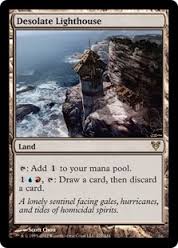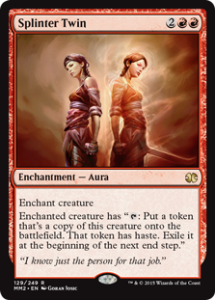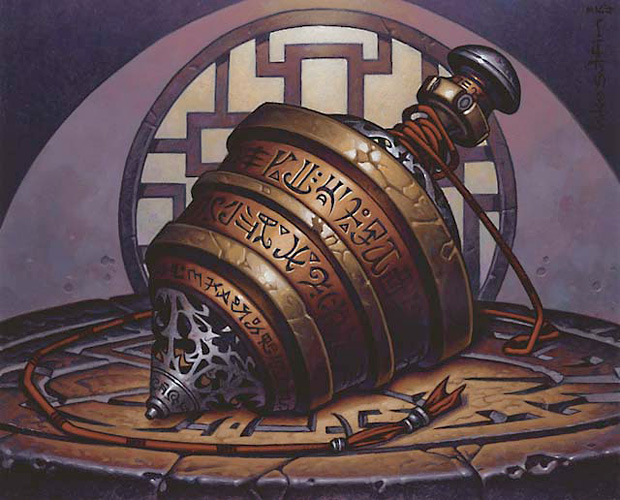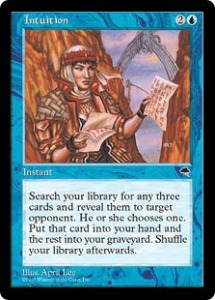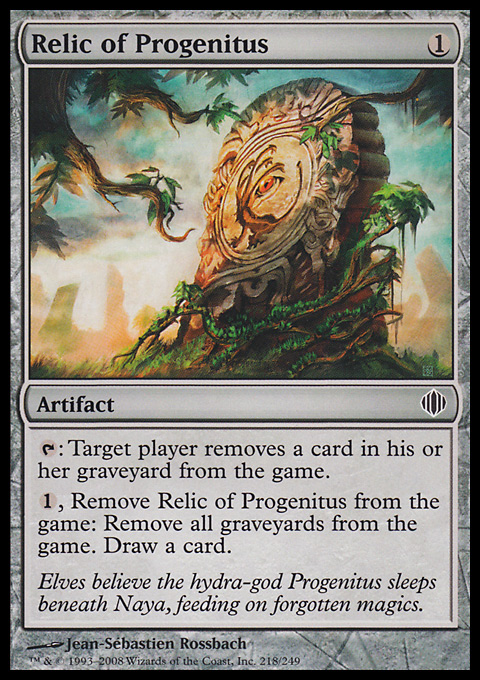The MKM Series in Toulouse happened just a few days ago, and with it the Legacy main event. Over a hundred people showed up to play in the tournament, making it a fairly large event. Out of all these people, only eight were left for the elimination rounds, and while there’s a lot to say about each individual decklist, first I want to take a look at what the top 8 itself looked like. Without further ado…
Grixis Delver
UWR Control
Four Color Delver
Grixis Aggro
UWR Control
Aggro Loam
BUG Control
MUD
Interestingly enough we see zero copies of Miracles in the top 8, despite the deck making up thirteen percent of the metagame, and twice as much as the second most played deck; ANT (a complete metagame breakdown can be found on their website). Both Four Color Delver and Aggro Loam (we really need a better name for that deck) however continued to impress, making a showing in yet another larger legacy event. This is just one event, and we should be careful not to read too much into these results. Still, when two decks keep consistently putting up top 8 finishes, that’s a sign that something’s going on. Right now Legacy is evolving, and we are witnessing the process.
While Miracles failed to impress this time, there was still plenty of control decks to be seen in the top 8, and lots of innovation. Miracles has long been the go-to control deck of the format, and it’s nice to see that there are other options. Let’s dive in and take closer look, starting with the winning list; UWR Control by Miguel Alcoriza.
Alcoriza Miguel – UWR Control
Land
1x PLAINS
2x ARID MESA
3x SCALDING TARN
3x TUNDRA
3x VOLCANIC ISLAND
4x FLOODED STRAND
4x ISLAND
Creature
3x SNAPCASTER MAGE
Instant
1x SECURE THE WASTES
4x FORCE OF WILL
2x COUNTERSPELL |
2x PYROBLAST2x FLUSTERSTORM
1x SPELL SNARE
4x DIG THROUGH TIME
4x BRAINSTORM
4x SWORDS TO PLOWSHARES
Sorcery
4x PONDER
4x PREORDAIN
1x SUPREME VERDICT
2x COUNCIL’S JUDGEMENT
Other
2x JACE, THE MIND SCULPTOR |
Sideboard
1x RED ELEMENTAL BLAST
1x BLOOD MOON
1x SUPREME VERDICT
2x WEAR/TEAR
2x SURGICAL EXTRACTION
2x PYROCLASM
2x VENDILION CLIQUE
4x MEDDLING MAGE |
|

This deck features sixteen pieces of library manipulation, eleven pieces of counter magic, seven removal spells and twenty lands, alongside two copies of Jace, the Mind Sculptor, three Snapcaster Mage and one Secure the Wastes as its win conditions.
Game one this deck has a lot of disruption, but no real clock or soft lock to put pressure on the combo decks. That changes quickly after sideboarding though, when the full four copies of Meddling Mage and two copies of Vendilion Clique are brought in to give you another angle of attack.
Rather than Terminus, this deck plays Supreme verdict, as the aforementioned miracle is less exciting when you don’t have Sensei’s Divining Top in your deck. What’s more interesting is the inclusion of the second Council’s Judgement. With both Aggro Loam and Four Color Delver on the rise, the decision to run a second copy makes a lot of sense, as it gives you more outs to some of the troublesome permanents seen in those decks, namely Sylvan Library and Chalice of the Void. With two copies of Council’s Judgement and a single Spell Snare, you should have a decent shot at combating those cards.
The biggest eyebrow-raiser in this deck is certainly the singleton Secure the Wastes, a card rarely seen in Legacy. As far as big spells go however it serves as a nice supplement for Entreat the Angels that also happens to work quite well with Snapcaster Mage. As a matter of fact, Secure the Wastes has many uses. You can play it on turn two to trade with an opposing Dark Confidant, or use it to hold off a Tarmogoyf later in the game, while simultaneously getting in for several points of damage every turn. It also deals excellently with Young Pyromancer, negating the value they would normally get from having a single card produce multiple bodies.
Next up we have Paul Ridoux and his MUD deck
Ridoux Paul – MUD
Land
2x CAVERN OF SOULS
2x VESUVA
4x WASTELAND
4x ANCIENT TOMB
4x CITY OF TRAITORS
4x CLOUDPOST
4x GLIMMERPOST
Artifact
1x SPINE OF ISH SAH
1x STAFF OF DOMINATION
2x LIGHTNING GREAVES
3x TRINISPHERE |
4x CHALICE OF THE VOID4x GRIM MONOLITH
Creature
1x BLIGHTSTEEL COLOSSUS
1x PLATINUM EMPERION
1x STEEL HELLKITE
1x SUNDERING TITAN
3x WURMCOIL ENGINE
4x KULDOTHA FORGEMASTER
4x LODESTONE GOLEM
4x METALWORKER
Other
2x UGIN, THE SPIRIT DRAGON |
Sideboard
1x DUPLICANT
2x PHYREXIAN REVOKER
1x CRUCIBLE OF WORLDS
1x DEFENSE GRID
1x ENSNARING BRIDGE
1x PITHING NEEDLE
2x WITCHBANE ORB
2x GRAFDIGGER’S CAGE
2x TORMOD’S CRYPT
2x ALL IS DUST |
|
Paul’s list seems to be a fairly stock MUD lists, with no really unconventional card choices. It has been established by now that Ugin, the Spirit Dragon deserves a spot in this deck, as the card has continuously proven its worth. Time will tell if Orb of Warding will replace Witchbane Orb in the sideboard going forward. It does cost an extra mana, but having a card that deals with both Tendrils of Agony and Empty the Warrens seems sweet.
Chalice of the Void is very well positioned right now, and MUD is definitely one of the better decks to take advantage of that. If you expect a lot of blue decks, perhaps it’s time you consider MUD.
The next deck on our list is Gabriel Deloison’s Grixis Delver deck, featuring a few gems of its own. I present to you…
Deloison Gabriel – Grixis Delver
Land
3x VOLCANIC ISLAND
1x TROPICAL ISLAND
3x UNDERGROUND SEA
3x SCALDING TARN
3x FLOODED STRAND
1x POLLUTED DELTA
Creature
4x DELVER OF SECRETS
4x DEATHRITE SHAMAN
3x YOUNG PYROMANCER
2x GURMAG ANGLER
1x TRUE-NAME NEMESIS |
Instant
4x DAZE
4x BRAINSTORM
4x FORCE OF WILL
4x LIGHTNING BOLT
2x DIG THROUGH TIME
1x KOLAGHAN’S COMMAND
1x SPELL PIERCE
Sorcery
4x PONDER
3x GITAXIAN PROBE
1x FORKED BOLT |
Sideboard
2x ABRUPT DECAY
1x KOLAGHAN’S COMMAND
2x PYROBLAST
1x RED ELEMENTAL BLAST
2x SURGICAL EXTRACTION
1x PITHING NEEDLE
1x GRAFDIGGER’S CAGE
1x SUBMERGE
2x CABAL THERAPY
1x FLUSTERSTORM
1x ELECTRICKERY |
Gabriel piloted his Grixis Delver list to a top 4 finish. Sadly this list is missing four cards, but seeing as there are only fourteen lands, I have an idea as to what the missing slots may be. Anyway, the card that catches my eye here is the one maindeck Kolaghan’s Command. Kolaghan’s Command is a highly versatile spell indeed, but normally the mana cost would be detrimental for its chances of being included in a deck like this. Grixis Delver does have a lot of trouble playing against Chalice of the Void, and in fact I beat the deck twice on the back of that card at GP Lille. It could be that the one Kolaghan’s Command is a concession to Chalice of the Void as a miser’s answer that is maindeckable thanks to still being live in other matchups.
The next thing to note is that there are only two copies of Cabal Therapy in the entire 75. In my experience with Grixis decks, their ability to completely rip a hand apart with Gitaxian Probe + Cabal Therapy has been one of its major strengths, which makes the decision to cut down on therapies seem questionable. With Gabriel opting to play Gurmag Angler and True-Name Nemesis, shaving a Gitaxian Probe and a Young Pyromancer however, the power level of Cabal Therapy goes down. Compared to its controlling counterpart, the Grixis Delver deck is a bit lacking in terms of staying power, so having a card like True-Name Nemesis to mitigate that weakness is definitely appealing. I’m not sure I agree with the way this deck is built, but I can definitely see where Gabriel is coming from.
Next up we have an interesting take on BUG Control, a deck that hasn’t been seeing too much play lately. Let’s take a look at what Carles Minion brought to the table!
Minion Carles – BUG
Land
2x ISLAND
1x FOREST
1x SWAMP
3x UNDERGROUND SEA
2x BAYOU
2x TROPICAL ISLAND
3x WASTELAND
4x POLLUTED DELTA
1x VERDANT CATACOMBS
3x MISTY RAINFOREST
1x CREEPING TAR PIT
Creature
2x TARMOGOYF
3x SNAPCASTER MAGE
1x TASIGUR, THE GOLDEN FANG
Instant
4x BRAINSTORM |
1x DIG THROUGH TIME4x ABRUPT DECAY
1x SPELL PIERCE
2x FLUSTERSTORM
4x FORCE OF WILL
2x COUNTERSPELL
Sorcery
1x PONDER
2x INNOCENT BLOOD
2x TOXIC DELUGE
1x LIFE FROM THE LOAM
2x THOUGHTSEIZE
Enchantment
1x PERNICIOUS DEED
Other
3x JACE, THE MIND SCULPTOR
2x LILIANA OF THE VEIL |
Sideboard
3x SURGICAL EXTRACTION
2x SCAVENGING OOZE
1x MAELSTROM PULSE
2x PERNICIOUS DEED
1x INNOCENT BLOOD
1x FLUSTERSTORM
1x GOLGARI CHARM
1x VENDILION CLIQUE
1x SYLVAN LIBRARY
1x UMEZAWA’S JITTE
1x NIHIL SPELLBOMB |
This deck aims to trade one for one with the opponent and then land a planeswalker to run away with the game. It has a lot of the traditional elements of BUG Control; discard spells, countermagic and removal. The singleton Spell Pierce looks a bit out of place in a deck that’s looking to go this long, but is very efficient early on, and can be made live later in the game thanks to Life from the Loam + Wasteland.
The anti synergy of Tarmogoyf and Innocent Blood is a little unfortunate, but having a creature that can stand in the way of opposing critters as well as live through Toxic Deluge can be quite valuable. This way your opponent will have to add more creatures to the table if they are to attack past your blocker, making your sweeper even better. Tasigur takes this one step further, as he survives Pernicious Deed in addition to Toxic Deluge.
After sideboard you have the option of adding even more creatures in the form of Scavenging Ooze and Vendilion Clique, enabling you to take a more proactive stance versus the combo decks, and potentially other control decks as well.
Game one versus combo your best bet is to get a Liliana of the Veil into play to keep their hand in check. A combination of hand disruption and permission should be enough to get there.
These BUG Control decks have a certain draw to them. It seems as if every card they draw has an impact on the game. There is very little ‘air’ in a deck like this, and the power level of each individual card is very high.
Rodriguez Pozo Javier – 4C Delver
Land
2x VOLCANIC ISLAND
2x UNDERGROUND SEA
2x TROPICAL ISLAND
2x FLOODED STRAND
2x MISTY RAINFOREST
3x POLLUTED DELTA
3x WASTELAND
3x SCALDING TARN
Creature
3x TARMOGOYF
4x DEATHRITE SHAMAN
1x SNAPCASTER MAGE |
4x DELVER OF SECRETS
Instant
3x DIG THROUGH TIME
4x FORCE OF WILL
4x DAZE
4x BRAINSTORM
2x SPELL PIERCE
3x ABRUPT DECAY
4x LIGHTNING BOLT
Sorcery
4x PONDER
Enchantment
1x SYLVAN LIBRARY |
Sideboard
1x SURGICAL EXTRACTION
2x GOLGARI CHARM
1x NULL ROD
1x SULFURIC VORTEX
2x SUBMERGE
1x VENDILION CLIQUE
2x FLUSTERSTORM
1x HYDROBLAST
1x RED ELEMENTAL BLAST
1x PYROBLAST
1x GRAFDIGGER’S CAGE
1x PITHING NEEDLE |
This is the stock Four Color Delver list. The deck has been making top 8 after top 8, placing very well in larger legacy tournaments lately. While these lists are very much alike, there are a few things to note about this one. First is the decision to play the 3-1 split between Tarmogoyf and Snapcaster Mage and the 19:th land over the maindeck Red Elemental Blast. This is the version that was taken to a top 8 at GP Lille by Petr Sochurek. Playing a 3-1 split makes sense when you don’t want to overload on Tarmogoyf, and because Snapcaster Mage is the more mana hungry card you want the extra land. Most of the time you will be flashing back a one mana spell, but every now and then you need a Dig Through Time or Abrupt Decay with your Snapcaster Mage, which is when the importance of the additional mana source becomes especially apparent.
In the sideboard we see a couple of interesting card choices that differ a bit from what we’re used to. Javier opted to go with a Grafdigger’s Cage and a Surgical Extraction over the two copies of Nihil Spellbomb that Petr Sochurek had in his sideboard. Surgical Extraction is quite strong with Snapcaster Mage, although not quite as good as when paired with discard spells. It also happens to be much better against Punishing Fire, a popular inclusion in Aggro Loam (or should I say Punishing Blue?) that can single handedly deal with almost all of your threats. Grafdigger’s Cage is great against Elves! and dedicated graveyard decks, and doesn’t mess with your Tarmogoyfs. I can definitely respect the decision to go with the more powerful card, even if it’s not as good against the top decks. Legacy is a diverse format, and stepping into a tournament you are likely to face a variety of decks.
Sulfuric Vortex is an interesting choice. Traditionally strong against Miracles it might seem like a sound decision, seeing as how that deck is currently very popular. To cast Sulfuric Vortex however you need double red, and unless you have a Deathrite Shaman that is a serious stretch if you also want to be playing Tarmogoyf and Abrupt Decay. Sulfuric Vortex does have some utility against Batterskull, but I’d much rather have access to Ancient Grudge in my sideboard. Especially now that many Miracles players have adopted Monastery Mentor, making them far better at taking a proactive stance and racing the enchantment, I would be hesitant to include Sulfuric Vortex outside of Burn.
Gonzalez Ruben – Grixis Aggro
Land
3x UNDERGROUND SEA
3x VOLCANIC ISLAND
4x SCALDING TARN
3x POLLUTED DELTA
1x FLOODED STRAND
1x BLOODSTAINED MIRE
1x MOUNTAIN
2x ISLAND
Creature
2x SNAPCASTER MAGE
1x TASIGUR, THE GOLDEN FANG
1x GURMAG ANGLER
4x YOUNG PYROMANCER |
Instant
4x BRAINSTORM
4x FORCE OF WILL
4x DIG THROUGH TIME
2x TERMINATE
1x RED ELEMENTAL BLAST
1x PYROBLAST
4x LIGHTNING BOLT
Sorcery
4x GITAXIAN PROBE
4x PONDER
4x CABAL THERAPY
Other
2x JACE, THE MIND SCULPTOR |
Sideboard
1x NULL ROD
1x PITHING NEEDLE
1x RED ELEMENTAL BLAST
1x ELECTRICKERY
2x FORKED BOLT
2x SPELL PIERCE
2x FLUSTERSTORM
3x SURGICAL EXTRACTION
2x BLOOD MOON |
This deck is listed as Grixis Aggro, and to be honest I don’t really see why. While it is certainly capable of coming out of the gates quickly with an army of Young Pyromancer tokens or an early Tasigur, the Golden Fang, it should be even better suited for games that go long. All your cards are very powerful and your answers are very efficient. The low land count and high density of cantrips means you will most likely be getting a steady stream of gas, and should provide you with both card quality advantage and virtual card advantage. Dig Through Time is also a beast going long, and this is one of the best Dig Through Time decks in the format. It is Grixis Control.
I finally picked up this deck a few days ago after having had my eyes on it for quite some time, and was super impressed with how consistently powerful it felt. There have been a few different variations of this deck going around, with the main difference being whether they play Deathrite Shaman or not. At first glance this might seem like just any other Grixis Control list, but there are a couple of interesting decisions here that I want to take a closer look at. First up we have the choice of removal spells. Four copies of Lightning Bolt is a given, but after that things start to get more interesting.
A singleton Murderous Cut was a common inclusion for a while, since it deals with most creatures for a small cost and this deck fills the graveyard so easily anyway. There are two main problems with Murderous Cut however, and they’re the reason I would stay away from the card right now. For starters, it is a lot worse on turn one, and having this in hand as your only removal spell when your opponent deploys a turn one Mother of Runes or Goblin Lackey is not a spot I want to be in. Secondly, while having enough feeding delve may not be a problem in a vacuum, you have to account for the fact that you also want to be chaining Dig Through Times. Other versions of this deck have had four additional cantrips, and sometimes even Thought Scour. Once you move away from those however, Murderous Cut gets a lot worse.
Forked Bolt is a card I like quite a bit, especially if you’re expecting a lot of Young Pyromancer mirrors. The problem is that it fails to shore up any of your weaknesses. You already have an answer to smaller creatures in Lightning Bolt. What you’re missing is a way to deal with all the Tarmogoyfs, Gurmag Anglers and Knight of the Reliquaries your opponent might throw at you, and Forked Bolt doesn’t help with any of that.
When I played this deck I had Terminate, and it’s a card I would play again. It’s not flashy, but it gets the job done. It does have the same problem as Murderous Cut with it being unable to answer a turn one play on the draw, but gets better as the game goes on. In a deck that is built to trade one for one it is essential that your removal spells do what they’re supposed to. Because of the low land count however you also need them to be efficient in order to not fall behind on tempo early on. This is why I think Terminate is a better fit for the sideboard, as games usually slow down a bit after board.
Next up we have the counter magic. When I played this deck it had three copies of Counterspell and a lone Jace, the Mind Sculptor. Ruben’s version has two Pyroblast effects and an additional copy of Jace. This can easily be explained by the fact that my metagame is less blue, with more creature decks seeing play, making Counterspell preferable over Pyroblast. Pyroblast also happens to be more narrow, and three copies feels a bit much, which means you get to fit in another Jace instead.
Romero Vilardell Adria – Jeskai Control
Land
3x ISLAND
4x POLLUTED DELTA
4x FLOODED STRAND
3x VOLCANIC ISLAND
3x TUNDRA
1x PLAINS
1x MISHRA’S FACTORY
1x KARAKAS
Creature
1x VENDILION CLIQUE
3x SNAPCASTER MAGE
Instant
4x FORCE OF WILL
2x LIGHTNING BOLT
4x SWORDS TO PLOWSHARES |
4x BRAINSTORM1x FLUSTERSTORM
1x SPELL PIERCE
3x DIG THROUGH TIME
1x PYROBLAST
2x COUNTERSPELL
Sorcery
4x PONDER
4x PREORDAIN
1x PYROCLASM
1x SUPREME VERDICT
2x COUNCIL’S JUDGEMENT
Other
2x JACE, THE MIND SCULPTOR |
Sideboard
2x BLOOD MOON
2x WEAR/TEAR
1x FLUSTERSTORM
1x VENDILION CLIQUE
2x SURGICAL EXTRACTION
3x MEDDLING MAGE
1x PYROCLASM
2x PYROBLAST
1x SECURE THE WASTES |
Ah, another innovative UWR Control list! It is very similar to the winning list, and even has the signature Secure the Wastes, only this time it’s in the sideboard. The fact that both decks made it to the top 8 is for me reason enough to at least have a closer look at the archetype. That will have to wait for another time though, as for now we’re going to examine the differences between the two lists.
Adria plays three additional removal spells (the two Lightning Bolts and the one-of Pyroclasm) where the other list had a second Pyroblast, a Spell Snare, and the fourth Dig Through Time. Eight pieces of dedicated creature removal might be too much, but when I play a deck like this I always want to have an answer ready for my opponent’s creatures. If you have to spend your cantrips looking for a removal spell you might find yourself shuffling away otherwise good cards or keeping bad Ponders just because you desperately need to answer their threat, and that is a recipe for failure. I’d much rather play it safe and not skimp on the removal. Having a second sweeper also takes a lot of the pressure off when facing an army of Young Pyromancer tokens, and Pyroclasm is a much more efficient answer than Secure the Wastes.
Having shaved some of the counter magic, Adria’s list is weaker to combo. To compensate for this, the singleton Secure the Wastes has been replaced with a Vendilion Clique, serving as both disruption and a victory condition.
Aside from Storm, Spell Snare also has a lot of utility against various problematic permanents, such as Counterbalance and Chalice of the Void. Having split the two copies of Flusterstorm in order to fit in a Spell Pierce ensures you still have as many ways to deal with these cards.
Chhen Patrick – Loam
Land
4x WASTELAND
3x VERDANT CATACOMBS
3x WINDSWEPT HEATH
3x GROVE OF THE BURNWILLOWS
2x BAYOU
2x TRANQUIL THICKET
1x TAIGA
1x SCRUBLAND
1x FOREST
1x SAVANNAH
1x BARREN MOOR
1x KARAKAS
1x MAZE OF ITH
1x URBORG, TOMB OF YAWGMOTH |
Artifact
4x CHALICE OF THE VOID
4x MOX DIAMOND
Creature
1x DRYAD ARBOR
4x DARK CONFIDANT
4x KNIGHT OF THE RELIQUARY
1x GADDOCK TEEG
1x DEATHRITE SHAMAN
1x SCAVENGING OOZE
Instant
3x PUNISHING FIRE
3x ABRUPT DECAY
Sorcery
2x GREEN SUN’S ZENITH
2x LIFE FROM THE LOAM
Enchantment
2x SYLVAN LIBRARY
Other
3x LILIANA OF THE VEIL |
Sideboard
2x ETHERSWORN CANONIST
2x CHOKE
2x GOLGARI CHARM
1x MAELSTROM PULSE
2x THOUGHTSEIZE
1x RECLAMATION SAGE
2x SLAUGHTER GAMES
3x LEYLINE OF THE VOID |
|
This is essentially the exact same list that we’ve seen repeatedly doing well in tournaments lately. The only change that has been made here was to replace the second copy of Barren Moor with a second Tranquil Thicket. Tranquil Thicket seems stronger in general, whereas Barren Moor helps cast Liliana of the Veil, and also works very well alongside Life from the Loam and Urborg, Tomb of Yawgmoth.
This deck just keeps performing extremely well over and over again. It’s time we recognise its place among the best decks in Legacy.
As for me, the journey outside my comfort zone has been great. I’ve kept my promise, trying new things in Legacy and playing better decks. So far I have tried both Grixis Control and Omnitell, going 4-0 and 3-1 respectively. My confidence as a player has been renewed, and I couldn’t be more excited to keep working on the format, exploring new ideas. There’s a WMCQ coming up, where I’ll be playing Mono Red, so for the time being most of my energy is directed towards learning the ropes in Standard.
Once the WMCQ is over however it’s all about Legacy, as the first season of our legacy league is coming to an end. Sixteen players will be competing for the title of Stockholm Legacy Champion, hundreds of dollars in legacy staples, and a handmade playmat by @PG_Alterations.

Until next time,
Sandro Rajalin
